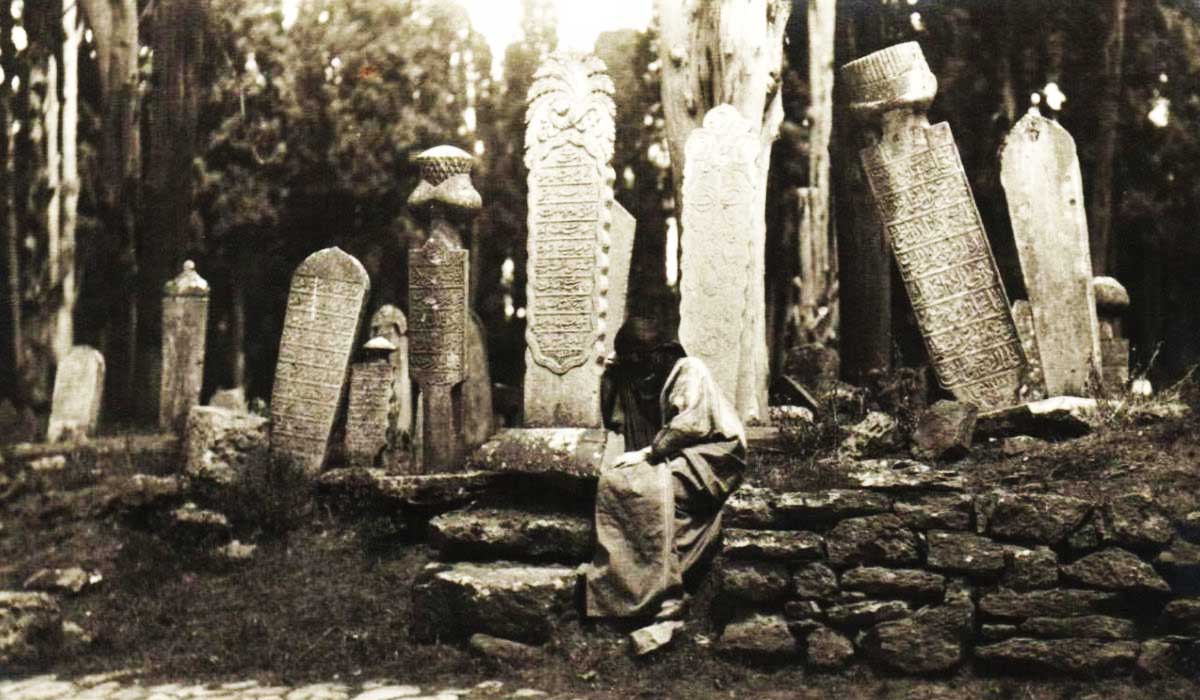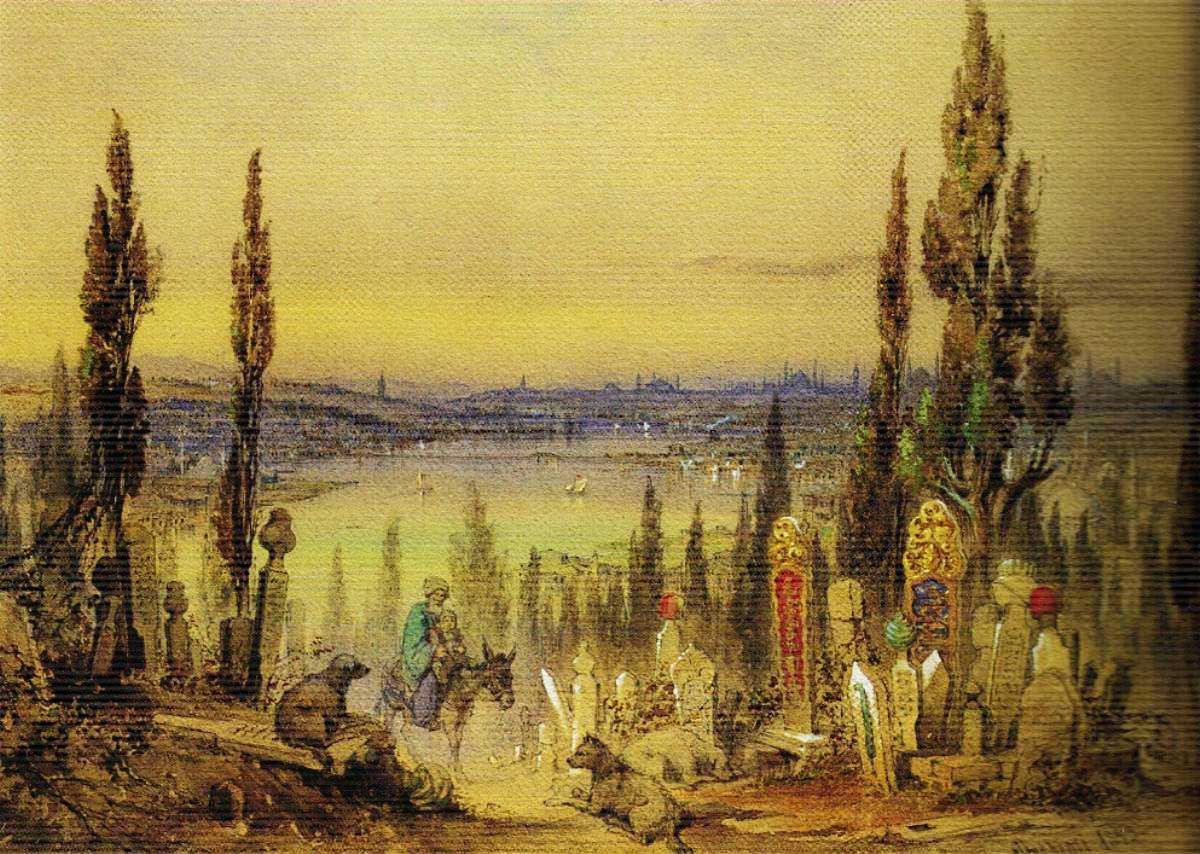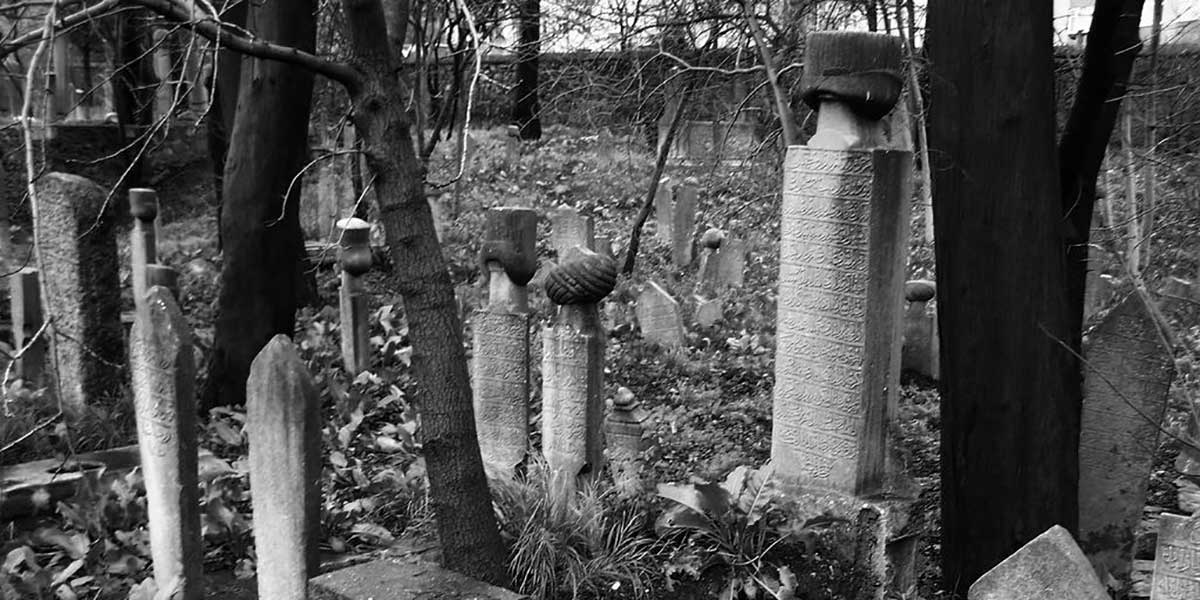Meaningful in-city reflections of a civilisation formed of alluvium carried by a river running towards art and poetry for centuries: İstanbul, an Ottoman city, and tombstones.
İlber Ortaylı starts the book named ‘‘Osmanlılar ve Ölüm’’ (Ottomans and Death), the preface of which he wrote, by quoting the statement from Andrê Malraux that ‘‘burial tools and tombstones are the most important signifier of identity for a civilisation.’’ And he goes with his own words to say, ‘‘Ottoman tombstones and funeral ceremonies show the main character of Ottoman people: modesty, taking death in cold blood, and indeed making death warm up to life…’’
When I took interest, in my own way, in city history, I ran into people, to my surprise, who received with astonishment the fact that graves that were in the treasury room of mosques were positioned in the middle of the city in accordance with the classical spatial distribution of Turkish-Islam cities—roughly: a mosque in the middle and around it a series of neighbourhoods dispersed towards the outside. Indeed, there were people who thought that the Hill of Pierre Loti, in Eyüp, was one of the most beautiful places of the city but the graves, which existed there in great numbers, deformed the beauty of this hill. I am sure there are people today as well who thinks in the same way. However, in my personal opinion, as someone from the Black Sea (We bury the dead very close to our houses, even in our gardens, for geographical, sociological and emotional reasons), I would hardly find any reason to go to Eyüp if we left out graveyards from Eyüp. This is because just like every city and town says something to people, so does Eyüp. Rather than from a bare hill, I would find it more meaningful to watch the scenery of Haliç along with the graves that make up the background of my frame. This meaning has always impressed me profoundly as someone from a civilisation with a custom of wrapping itself up in death while loving, walking, living. However, in modern times, graveyards have been pushed out of cities and we grew up forgetting, while becoming modern, death and what it tells us. And we still keep growing. Ultimately the sensibility in the comment of İlber Ortaylı regarding Ottoman grave stones, ‘‘making death warm up to life,’’ has long abandoned us. In addition to this comment, Ahmet Hamdi Tanpınar also touches upon taming death in parallel with İlber Ortaylı: ‘‘Regarding the east, they say that it has the secret of death. However, there is no nation, except for us, even among eastern nations that frames death as much as we do and tames it while at same time refraining from any kind of levity.’’ And he concludes saying that graveyards represent a third time zone just like a bridge in the middle of old Turkish cities that can easily be eroded. Our disconnection with this third time zone nowadays has made death, which Ottoman gravestones has softened for us, creepier than its existence. As a result, as Tanpınar puts it, since it is no longer possible ‘‘for the death to witness all the life on the street through their place of residence,’’ graveyards have gotten away from cities, literary and artistic softness and creepy. Yet everybody knows Yahya Kemal’s notion that he articulated when he was working as the Madrid ambassador that ‘‘We live together with the dead.’’ We are so afraid of graveyards that remind us of death, as well as the death that Rumi calls ‘‘Şeb-i Arûs’’ since we have lost that subtle sensibility which Yahya Kemal points out. And this fear has caused gravestones to be pieces of marble that are prepared in a trice and functions merely as information conveyers as a result of the notion that no more than the name and place of the dead person is necessary. However, such a beautiful and meaningful were the art and literary spirit in Ottoman gravestones…
I would like to go on by quoting from Gülizar Haydar’s perfect book called ‘‘Şehirlerin Ruhu’’ (Spirit of Cities). Gülizar Haydar describes cities saying, ‘‘A city is like a school without a building, a library without any books and a classroom without a blackboard and chalk.’’ So he meant that city is a teacher. What is left for us to do is to ask question to the teacher in this school from which we will never graduate and learn as much as we can. Especially for those of us living under a teacher as experienced as İstanbul, not asking questions, living without talking to her, must be an unexplainable mistake. I am one of those who think that it is the alms of to be living in İstanbul to be able to ask at least why Adalet Kulesi (Justice Tower) rising right next to the Imperial Council (Divan-I Hümayun) among the buildings in Topkapı Palace is higher than all other building in that palace. Or, I believe we must be able to comprehend in what dimension a reference is made to our temporary situation when we see the corroded marble threshold of the inside doors of Hagia Sophia. On the other hand, I expressed that Gülizar Haydar called cities a teacher. In the further chapters of the book, the author points out a circle by saying, ‘‘A city teaches what it learns.’’ In this regard, İstanbul has been teaching us all she has learned for decades. At the moment the new generation is teaching her new things, and in the future our grandchildren will learn what we teach her. We are now learning what those people who corroded the marble threshold of Hagia Sophia taught this city. They, indeed, taught us grace, art, feelings and pleasure. And I do not know what we will able to teach the next generation with our skyscrapers, huge shopping malls and graveyards that we have pushed out of the city.
I will end this text by concluding in regards with Ottoman gravestones through which İstanbul tried to teach us grace even in death. It is obvious that Fatih, Üsküdar and Eyüp are quite famous among İstanbul towns with their graveyards. Since these towns are the most densely-populated places of residence in the old İstanbul, they are a must-visit for people who are curious about the past with their historical web. I should add that a lot of things people are looking for who do not possess a wall of difference in the comprehension of what is seen and what is not seen are hidden in these towns.
Among these towns Fatih is a local and foreign tourist attraction every year due to Süleymaniye Mosque which is one of symbolic buildings of İstanbul. Unfortunately, it is not possible for me to convey the effect exerted upon me when I visit this great sanctuary every time I visit it. Every time I visit there, I watch the splendid Bosporus scenery and see people who cannot hide their astonishment against the scenery they behold. However, the number of people fascinated by the scenery is bigger than the number of people visiting the hazire (burial area reserved for special people especially in mosques or sufi lodges) of Süleymaniye Mosque. As to me, I define this graveyard scenery that exists beyond this spectacular Bosporus scenery as ‘‘the beyond of Süleymaniye’’. There is such a scenery beyond the great Bosporus scenery. Just like all the gravestones existing in the middle of city are trying to tell us:
[su_quote]Hüve’l- Bâkî
(It is He who is permanent)
Gel efendim nazar eyle şu mezârım taşına
(Come, oh my Effendi, fix your gaze on my gravestone)
Âkil isen gâfil olma aklını al başına
(If you are smart enough, act wisely)
Salınıp gezerdim bak neler geldi başıma
(I used to wander all around, see what has happened to me?)
Âkibet öldüm taş dikildi başıma
(I died in the end, a gravestone erected upon me.)[/su_quote]
A naïve voice calling from that third dimension Ahmet Hamdi Tanpınar talks about leaves me hanging in midair every single time. It gives one undefinable feelings to walk on that stony road that divides into two the area where there are shrines of Süleyman the Magnificent and Hürrem Sultan along with the graves that appear especially at the end of the mosque. Because each and every one of them talks to you. It should not deceive one that they stand silently, and it should be ignored that they are called ‘‘Hamûşan’’ in Rumi language. They express a lot of things about us and themselves in a very artistic language by staying silent.
I will end the text by mentioning that grave which bewildered me the first time I saw it in the hazire of Süleymaniye Mosque. The grace is truly astonishing in the grave of a lady, who passed away at the age of 17, that is on the left side when you enter the hazire from the side of dried bean sellers, towards the kiblah wall of the mosque. This grave, which is quite famous among people who are curious about Ottoman gravestones and wander back and forth around graveyards, has a bride’s veil in the head stone that symbolises that she passed away before she got married; and in the written part of this head stone, which is covered by the bride’s veil, how she passed away before she got married is explained. On the other hand, in the foot stone, there is a very subtle, naïve symbol symbolising that she passed away at a very early age: a broken rose. The explanation of a young lady’s death through a broken rose is a poem carved on a stone, in my opinion. The epitaph of the grave tells us about this:
“Ey zair, şu taşın altında yatan genç kızların en pâk ve afîf ve en zekî ve en güzellerinden biri idi, heyhat ecel onu on yedi yaşında şu gördüğün toprağa serdi. Yegâne emeli olduğu ailesinin kalbgâhından mevtin henüz pek taze iken kopardığı bu nadide çiçek, nûr-i zekâ ve malumat ile mümtaz hüsn-i ahlâk ve namusa mücessem misal idi. Ruh-ı masumu için Fatiha. Fi 13 Kanun-ı Sâni sene 1325 (26 ocak 1910) yevm-i Çarşamba.” (Oh visitor, this young woman lying beneath this stone was one of those cleanest, purest and smartest. The fate laid her on the soil that you are beholding now. This rare flower, which death picked when she was so young, was one of the finest examples of intellect and chastity. Recite Al-Fatehah for her innocent soul. 26 January, 1910. Wednesday.)
I do not know what is there to say for these statements. The explanation of death in this language of grace informs us of a reality including quite profound meanings, and the fact that this civilisation in which that reality is comprehended has a lot more to tell us. Ottoman gravestone art and literature are truly an omani. I believe that every person living on this land should get their share from it. Not only in İstanbul, but in every corner of Ottoman geography you may run into a grave that a captain under sail as if leading his ship with broken posts, a chain and ropes, or a grave in which a lady who passed away at a young age is expressed with a broken rose. You can understand at first sight what job the person had when he was alive, how he died and what kind of a personality he or she had. Because he or she keeps talking. And they utter the first words as if in a chatting room and you step into the third dimensional time zone Ahmet Hamdi Tanpınar talks about by replying to this first utterance. It will not take time for you to understand when an artist tells you something with their colours and pallet, and a musician with his notes, reed and qanun. While it is fairly easy to talk to them with these symbols, it is also fairly easy to talk to executioner graves that do not have any writing on it and own stones not sculpted roughly (Of course, if you can find them. Their number in İstanbul has gone down fairly for various reasons. If you look for them at the back of Eyüp, in the graves near the shrine of Karyağdı Baba, you can still see some of them). They tell you their situation without any symbols or words. Also the graves being lost teaches you something. For instance if you happen to ask yourself why the stones of janissary graves are so rare, you can find the answer to this question by going as far back as the removal of the Guild of Janissaries in 1826.





